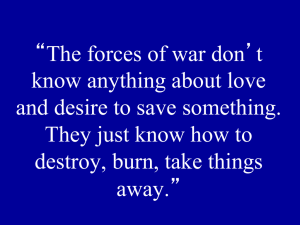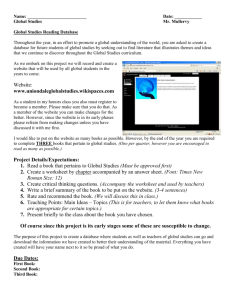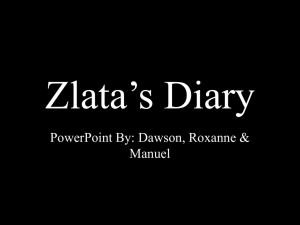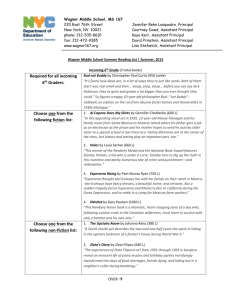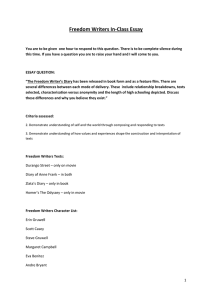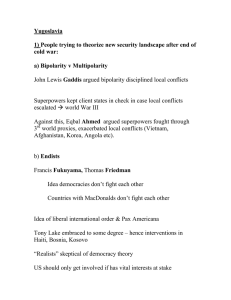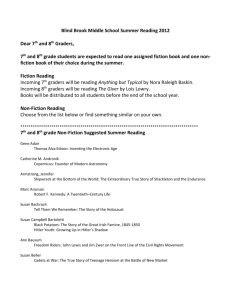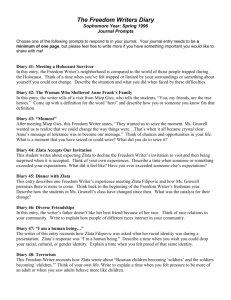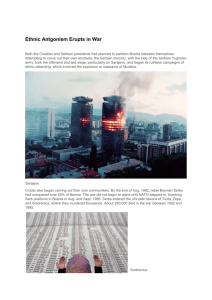Other Genocides: Teaching Using Zlata’s Diary by Janet Santo-Gruner
advertisement
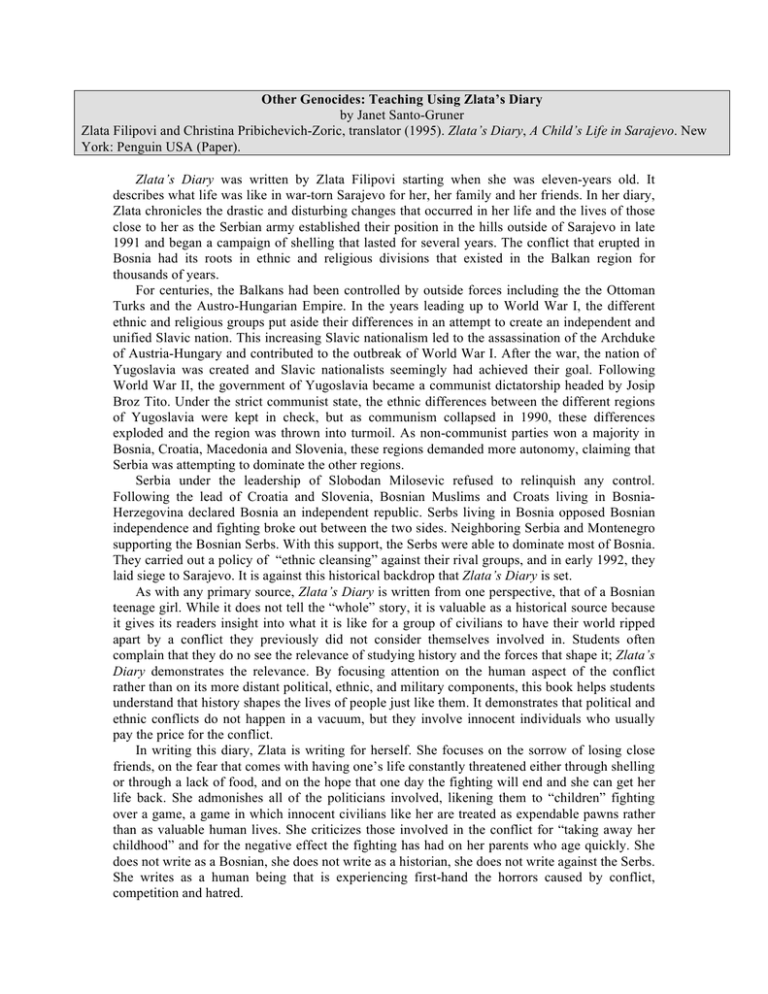
Other Genocides: Teaching Using Zlata’s Diary by Janet Santo-Gruner Zlata Filipovi and Christina Pribichevich-Zoric, translator (1995). Zlata’s Diary, A Child’s Life in Sarajevo. New York: Penguin USA (Paper). Zlata’s Diary was written by Zlata Filipovi starting when she was eleven-years old. It describes what life was like in war-torn Sarajevo for her, her family and her friends. In her diary, Zlata chronicles the drastic and disturbing changes that occurred in her life and the lives of those close to her as the Serbian army established their position in the hills outside of Sarajevo in late 1991 and began a campaign of shelling that lasted for several years. The conflict that erupted in Bosnia had its roots in ethnic and religious divisions that existed in the Balkan region for thousands of years. For centuries, the Balkans had been controlled by outside forces including the the Ottoman Turks and the Austro-Hungarian Empire. In the years leading up to World War I, the different ethnic and religious groups put aside their differences in an attempt to create an independent and unified Slavic nation. This increasing Slavic nationalism led to the assassination of the Archduke of Austria-Hungary and contributed to the outbreak of World War I. After the war, the nation of Yugoslavia was created and Slavic nationalists seemingly had achieved their goal. Following World War II, the government of Yugoslavia became a communist dictatorship headed by Josip Broz Tito. Under the strict communist state, the ethnic differences between the different regions of Yugoslavia were kept in check, but as communism collapsed in 1990, these differences exploded and the region was thrown into turmoil. As non-communist parties won a majority in Bosnia, Croatia, Macedonia and Slovenia, these regions demanded more autonomy, claiming that Serbia was attempting to dominate the other regions. Serbia under the leadership of Slobodan Milosevic refused to relinquish any control. Following the lead of Croatia and Slovenia, Bosnian Muslims and Croats living in BosniaHerzegovina declared Bosnia an independent republic. Serbs living in Bosnia opposed Bosnian independence and fighting broke out between the two sides. Neighboring Serbia and Montenegro supporting the Bosnian Serbs. With this support, the Serbs were able to dominate most of Bosnia. They carried out a policy of “ethnic cleansing” against their rival groups, and in early 1992, they laid siege to Sarajevo. It is against this historical backdrop that Zlata’s Diary is set. As with any primary source, Zlata’s Diary is written from one perspective, that of a Bosnian teenage girl. While it does not tell the “whole” story, it is valuable as a historical source because it gives its readers insight into what it is like for a group of civilians to have their world ripped apart by a conflict they previously did not consider themselves involved in. Students often complain that they do no see the relevance of studying history and the forces that shape it; Zlata’s Diary demonstrates the relevance. By focusing attention on the human aspect of the conflict rather than on its more distant political, ethnic, and military components, this book helps students understand that history shapes the lives of people just like them. It demonstrates that political and ethnic conflicts do not happen in a vacuum, but they involve innocent individuals who usually pay the price for the conflict. In writing this diary, Zlata is writing for herself. She focuses on the sorrow of losing close friends, on the fear that comes with having one’s life constantly threatened either through shelling or through a lack of food, and on the hope that one day the fighting will end and she can get her life back. She admonishes all of the politicians involved, likening them to “children” fighting over a game, a game in which innocent civilians like her are treated as expendable pawns rather than as valuable human lives. She criticizes those involved in the conflict for “taking away her childhood” and for the negative effect the fighting has had on her parents who age quickly. She does not write as a Bosnian, she does not write as a historian, she does not write against the Serbs. She writes as a human being that is experiencing first-hand the horrors caused by conflict, competition and hatred. It is difficult to read the diary without wondering, as Zlata does, why? Why all the fighting, why all the hatred, why all of the destruction? Once this happens, the history behind the conflict becomes more than just history, it becomes the context of a person’s life and as such, the students will be more likely to want to understand it. In class, I combine discussion of the book with newspaper accounts of ethnic cleansing and the trial of Slobodan Milosevic for crimes against humanity.
